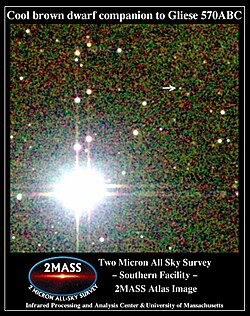| Observation data Epoch J2000.0 Equinox J2000.0 | |
|---|---|
| Constellation | Libra |
| Right ascension | 14h 57m 28.00144s [1] |
| Declination | −21° 24′ 55.7131″ [1] |
| Apparent magnitude (V) | 5.75 / 8.07 / 10.5 |
| Characteristics | |
| Spectral type | K4V / M1V / M3V / T7V |
| U−B color index | 1.06 /1.22 |
| B−V color index | 1.11 / 1.51 |
| Variable type | None / BY Dra |
| Astrometry | |
| A | |
| Radial velocity (Rv) | +26.75±0.12 [2] km/s |
| Proper motion (μ) | RA: +1031.472 mas/yr [2] Dec.: −1723.619 mas/yr [2] |
| Parallax (π) | 169.8843±0.0653 mas [2] |
| Distance | 19.199 ± 0.007 ly (5.886 ± 0.002 pc) |
| Absolute magnitude (MV) | 6.89 [3] |
| BC | |
| Radial velocity (Rv) | +25.9 [4] km/s |
| Proper motion (μ) | RA: +961.78 [1] mas/yr Dec.: −1677.83 [1] mas/yr |
| Parallax (π) | 169.1±0.9 mas [5] |
| Distance | 19.3 ± 0.1 ly (5.91 ± 0.03 pc) |
| Absolute magnitude (MV) | 9.19 [3] / 11.05 |
| D | |
| Proper motion (μ) | RA: +1038.08 [6] mas/yr Dec.: −1677.59 [6] mas/yr |
| Parallax (π) | 169.30±1.70 mas [7] |
| Distance | 19.3 ± 0.2 ly (5.91 ± 0.06 pc) |
| Orbit [5] | |
| Primary | B |
| Companion | C |
| Period (P) | 308.86±0.01 days |
| Semi-major axis (a) | 148.1±0.5 mas |
| Eccentricity (e) | 0.758±0.001 |
| Inclination (i) | 106.1±0.1° |
| Longitude of the node (Ω) | 16.9±0.2° |
| Periastron epoch (T) | 50270.86±0.04 |
| Argument of periastron (ω) (secondary) | 308.3±0.2° |
| Semi-amplitude (K1) (primary) | 18.23±0.06 km/s |
| Semi-amplitude (K2) (secondary) | 27.2±0.1 km/s |
| Details | |
| A | |
| Mass | 0.802 ± 0.040 [8] M☉ |
| Radius | 0.715±0.009 [9] R☉ |
| Luminosity (bolometric) | 0.19±0.01 [9] L☉ |
| Temperature | 4505±76 [9] K |
| Metallicity | [8] |
| Rotational velocity (v sin i) | 1.50 [8] km/s |
| B | |
| Mass | 0.562±0.006 [5] M☉ |
| Radius | 0.615 ± 0.039 [10] [a] R☉ |
| Luminosity | 0.053±0.006 [10] L☉ |
| Temperature | 3530+46 −45 [10] K |
| C | |
| Mass | 0.377±0.003 [5] M☉ |
| Radius | 0.399 ± 0.028 [10] [b] R☉ |
| Luminosity | 0.0171+0.0021 −0.0019 [10] L☉ |
| Temperature | 3304+64 −63 [10] K |
| D | |
| Mass | 34.6+7.5 −6.5 [11] MJup |
| Radius | 0.89+0.05 −0.04 [11] RJup |
| Luminosity | 2.88+0.21 −0.19×10−7 [11] L☉ |
| Surface gravity (log g) | 5.04±0.13 [11] cgs |
| Temperature | 786±20 [11] K |
| Other designations | |
| 33 G. Librae, GJ 570, ADS 9446, WDS J14575-2125 [12] | |
| A: KX Lib, BD−20°4125, FK5 1391, HD 131977, HIP 73184, HR 5568, SAO 183040, LAL 27173, LFT 1161, LHS 387, LPM 551, LTT 5949, PLX 3375, MCC 726 | |
| BC: BD−20°4123, HD 131976, HIP 73182, SAO 183039, LFT 1160, LHS 386, LPM 550, LTT 5948 | |
| D: 2MASS J14571496-2121477 | |
| Database references | |
| SIMBAD | A |
| BC | |
| D | |
| Exoplanet Archive | data |
| ARICNS | data |
Gliese 570 (or 33 G. Librae) is a quaternary star system approximately 19 light-years away. The primary star is an orange dwarf star (much dimmer and smaller than the Sun). The other secondary stars are themselves a binary system, two red dwarfs that orbit the primary star. A brown dwarf has been confirmed to be orbiting in the system.





